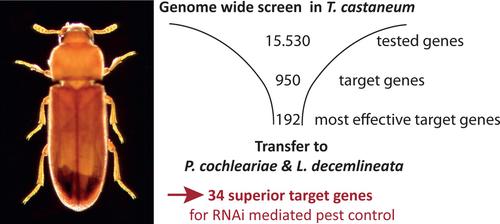当前位置:
X-MOL 学术
›
Pest Manag. Sci.
›
论文详情
Our official English website, www.x-mol.net, welcomes your
feedback! (Note: you will need to create a separate account there.)
Superior target genes and pathways for RNAi‐mediated pest control revealed by genome‐wide analysis in the beetle Tribolium castaneum
Pest Management Science ( IF 3.8 ) Pub Date : 2024-11-05 , DOI: 10.1002/ps.8505 Benjamin Buer, Jürgen Dönitz, Martin Milner, Sonja Mehlhorn, Claudia Hinners, Janna Siemanowski‐Hrach, Julia K. Ulrich, Daniela Großmann, Doga Cedden, Ralf Nauen, Sven Geibel, Gregor Bucher
Pest Management Science ( IF 3.8 ) Pub Date : 2024-11-05 , DOI: 10.1002/ps.8505 Benjamin Buer, Jürgen Dönitz, Martin Milner, Sonja Mehlhorn, Claudia Hinners, Janna Siemanowski‐Hrach, Julia K. Ulrich, Daniela Großmann, Doga Cedden, Ralf Nauen, Sven Geibel, Gregor Bucher

|
BACKGROUNDAn increasing human population, the emergence of resistances against pesticides and their potential impact on the environment call for the development of new eco‐friendly pest control strategies. RNA interference (RNAi)‐based pesticides have emerged as a new option with the first products entering the market. Essentially, double‐stranded RNAs targeting essential genes of pests are either expressed in the plants or sprayed on their surface. Upon feeding, pests mount an RNAi response and die. However, it has remained unclear whether RNAi‐based insecticides should target the same pathways as classic pesticides or whether the different mode‐of‐action would favor other processes. Moreover, there is no consensus on the best genes to be targeted.RESULTSWe performed a genome‐wide screen in the red flour beetle to identify 905 RNAi target genes. Based on a validation screen and clustering, we identified the 192 most effective target genes in that species. The transfer to oral application in other beetle pests revealed a list of 34 superior target genes, which are an excellent starting point for application in other pests. Gene ontology (GO) and Kyoto encyclopedia of genes and genomes (KEGG) analyses of our genome‐wide dataset revealed that genes with high efficacy belonged mainly to basic cellular processes such as gene expression and protein homeostasis – processes not targeted by classic insecticides.CONCLUSIONOur work revealed the best target genes and target processes for RNAi‐based pest control and we propose a procedure to transfer our short list of superior target genes to other pests. © 2024 The Author(s). Pest Management Science published by John Wiley & Sons Ltd on behalf of Society of Chemical Industry.
中文翻译:

通过全基因组分析揭示甲虫 Tribolium castaneum 中 RNAi 介导的害虫防治的优越靶基因和通路
背景随着人口的增加,对杀虫剂的耐药性及其对环境的潜在影响的出现要求制定新的环保害虫防治策略。随着第一批产品进入市场,基于 RNA 干扰 (RNAi) 的杀虫剂已成为一种新的选择。从本质上讲,靶向害虫基本基因的双链 RNA 要么在植物中表达,要么喷洒在植物表面。进食后,害虫产生 RNAi 反应并死亡。然而,目前尚不清楚基于 RNAi 的杀虫剂是否应该针对与传统杀虫剂相同的途径,或者不同的作用模式是否有利于其他过程。此外,对于最佳靶向基因尚未达成共识。结果我们对红粉甲虫进行了全基因组筛选,以鉴定 905 个 RNAi 靶基因。基于验证筛选和聚类,我们确定了该物种中 192 个最有效的靶基因。转移到其他甲虫害虫的口服应用揭示了 34 个优势靶基因的清单,这是应用于其他害虫的极好起点。基因本体论 (GO) 和京都基因与基因组百科全书 (KEGG) 对我们全基因组数据集的分析表明,高效基因主要属于基本的细胞过程,例如基因表达和蛋白质稳态——经典杀虫剂不针对的过程。结论我们的工作揭示了基于 RNAi 的害虫防治的最佳靶基因和靶过程,我们提出了一种程序,将我们的优良靶基因短列表转移到其他害虫。© 2024 作者。由John Wiley & Sons Ltd代表化学工业协会出版的《害虫管理科学》。
更新日期:2024-11-05
中文翻译:

通过全基因组分析揭示甲虫 Tribolium castaneum 中 RNAi 介导的害虫防治的优越靶基因和通路
背景随着人口的增加,对杀虫剂的耐药性及其对环境的潜在影响的出现要求制定新的环保害虫防治策略。随着第一批产品进入市场,基于 RNA 干扰 (RNAi) 的杀虫剂已成为一种新的选择。从本质上讲,靶向害虫基本基因的双链 RNA 要么在植物中表达,要么喷洒在植物表面。进食后,害虫产生 RNAi 反应并死亡。然而,目前尚不清楚基于 RNAi 的杀虫剂是否应该针对与传统杀虫剂相同的途径,或者不同的作用模式是否有利于其他过程。此外,对于最佳靶向基因尚未达成共识。结果我们对红粉甲虫进行了全基因组筛选,以鉴定 905 个 RNAi 靶基因。基于验证筛选和聚类,我们确定了该物种中 192 个最有效的靶基因。转移到其他甲虫害虫的口服应用揭示了 34 个优势靶基因的清单,这是应用于其他害虫的极好起点。基因本体论 (GO) 和京都基因与基因组百科全书 (KEGG) 对我们全基因组数据集的分析表明,高效基因主要属于基本的细胞过程,例如基因表达和蛋白质稳态——经典杀虫剂不针对的过程。结论我们的工作揭示了基于 RNAi 的害虫防治的最佳靶基因和靶过程,我们提出了一种程序,将我们的优良靶基因短列表转移到其他害虫。© 2024 作者。由John Wiley & Sons Ltd代表化学工业协会出版的《害虫管理科学》。


















































 京公网安备 11010802027423号
京公网安备 11010802027423号